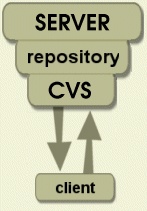1.3.2 Using CVS Locally: Committing Changes

Before modifying the source, you should update your
current repository to capture any changes made since you last checked
out. Use the CVS update command to do this:
cvs update -P -d .
Options:
|
-P
|
prunes existing empty directories.
|
|
-d
|
builds a directory if it does not exist.
|
|
.
|
installs in the current directory;
another directory path name may be substituted.
|
Once you have updated your repository, use the CVS edit command to lock
file access by other programmers while you make changes to the source:
where "." allows edits to all files in your current directory. You can
use specific filenames as alternatives, or standard command line
regular expressions.
|

|
Note that this simply locks file access while you "edit".
Once you have issued this command, you may then use your preferred
text editor to modify source files.
When you are ready
to commit your source file changes to the repository, use the CVS commit
command:
where "." commits changes to all files in the current directory.
See our
workshop notes
for further examples of how to use CVS.
Once you have acquired a copy of the software, you are now ready for
compilation. Follow the configuration and compilation instructions in
Section 1.5.
|
|